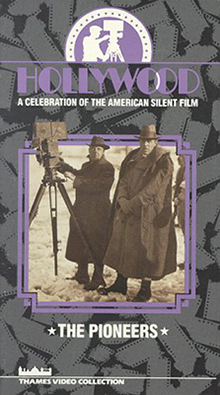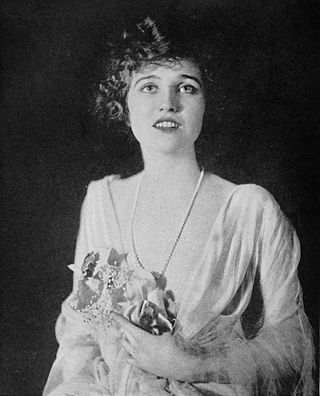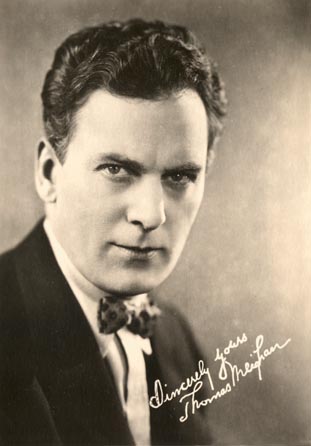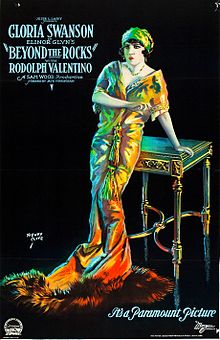
Rodolfo Pietro Filiberto Raffaello Guglielmi di Valentina d'Antonguella, known professionally as Rudolph Valentino and nicknamed The Latin Lover, was an Italian actor based in the United States who starred in several well-known silent films including The Four Horsemen of the Apocalypse,The Sheik,Blood and Sand,The Eagle, and The Son of the Sheik.

Gloria Josephine Mae Swanson was an American actress. She first achieved fame acting in dozens of silent films in the 1920s and was nominated three times for the Academy Award for Best Actress, most famously for her 1950 turn in Billy Wilder's Sunset Boulevard, which also earned her a Golden Globe Award.
This is an overview of 1922 in film, including significant events, a list of films released and notable births and deaths.

Beyond the Rocks is a 1906 novel by Elinor Glyn. The novel was later adapted into a 1922 silent film in which Gloria Swanson and Rudolph Valentino starred together for the only time. The film was directed by Sam Wood and distributed by Paramount Pictures.

Hollywood is a British television documentary miniseries produced by Thames Television and originally broadcast on ITV in 1980. Written and directed by film historians Kevin Brownlow and David Gill, it explored the establishment and development of the Hollywood studios and their cultural impact during the silent film era of the 1910s and '20s. At the 1981 BAFTA TV Awards, the series won for Best Original Television Music and was nominated for Best Factual Series, Best Film Editing and Best Graphics.

Male and Female is a 1919 American silent adventure/drama film directed by Cecil B. DeMille and starring Gloria Swanson and Thomas Meighan. Its main themes are gender relations and social class. The film is based on the 1902 J. M. Barrie play The Admirable Crichton.

Agnes Ayres was an American actress who rose to fame during the period of silent films. She was known for her role as Lady Diana Mayo in The Sheik opposite Rudolph Valentino.

Lois Wilson was an American actress who worked during the silent film era. She also directed two short films and was a scenario writer.

Julia Faye Maloney, known professionally as Julia Faye, was an American actress of silent and sound films. She was known for her appearances in more than 30 Cecil B. DeMille productions. Her various roles ranged from maids and ingénues to vamps and queens.

Camille is a 1921 American silent drama film starring Alla Nazimova as Marguerite and Rudolph Valentino as her lover, Armand. It is based on the play adaptation La Dame aux Camélias by Alexandre Dumas, fils, which was first published in French as a novel in 1848 and as a play in 1852. Camille is one of numerous screen adaptations of Dumas, fils' story. The film is set in 1920s Paris, whereas the original version takes place in Paris in the 1840s. It has lavish Art Deco sets; Rudolph Valentino later married the film's art director, Natacha Rambova.

Osmond Hudson Borradaile was a Canadian cameraman, cinematographer, and veteran of World War I and World War II.

Thomas Meighan was an American actor of silent films and early talkies. He played several leading-man roles opposite popular actresses of the day, including Mary Pickford and Gloria Swanson. At one point he commanded $10,000 per week.

Don't Change Your Husband is a 1919 American silent comedy film directed by Cecil B. DeMille and starring Gloria Swanson. The film was the third of six "marriage films" directed by DeMille and the first DeMille film starring Gloria Swanson. A print of the film is stored at the George Eastman House. The film was released on DVD by Image Entertainment with The Golden Chance. A Chinese silent film, Don't Change Your Husband (1929), used the same English title, and a similar plot arc.

For Better, for Worse is a 1919 American silent drama film directed by Cecil B. DeMille and starring Gloria Swanson. The film was the second of four "marriage films" directed by DeMille and the second DeMille film starring Gloria Swanson. For Better, for Worse was adapted for the screen by William C. DeMille. Jeanie MacPherson wrote the film's scenario.

Something to Think About is a 1920 American silent drama film directed by Cecil B. DeMille. The film stars Elliott Dexter and Gloria Swanson. Prints of the film exist at the George Eastman Museum in Rochester, New York, and at the Filmmuseum in Amsterdam.

Return to Babylon is a 2013 black-and-white silent film about the silent film era. It was directed by Alex Monty Canawati. It stars an ensemble cast of Jennifer Tilly, María Conchita Alonso, Ione Skye, Debi Mazar, Laura Harring, and Tippi Hedren.

Society for Sale is a 1918 American silent drama film directed by Frank Borzage and starring William Desmond and Gloria Swanson. It is not known whether the film currently survives, which suggests that it is a lost film.

Eyes of Youth is a 1919 American silent drama film directed by Albert Parker and starring Clara Kimball Young. The film was based on the stage play Eyes of Youth, performed on Broadway in 1917-18 and starred Marjorie Rambeau. This film also features Rudolph Valentino in a role as a thief/con artist.
A Society Scandal is a 1924 American silent drama film directed by Allan Dwan, and starring Gloria Swanson and Rod La Rocque. Distributed by Paramount Pictures, the film is based on a 1922 play The Laughing Lady, by Alfred Sutro which starred Ethel Barrymore in 1923 on Broadway and originally in 1922 with Edith Evans in UK.

A Trip to Paramountown is a 1922 American short silent documentary film produced by Famous Players–Lasky and released through Paramount Pictures, to celebrate 10 years of Paramount's founding. The film runs about 20 minutes and features many personalities then under contract to Famous Players–Lasky and Paramount.























